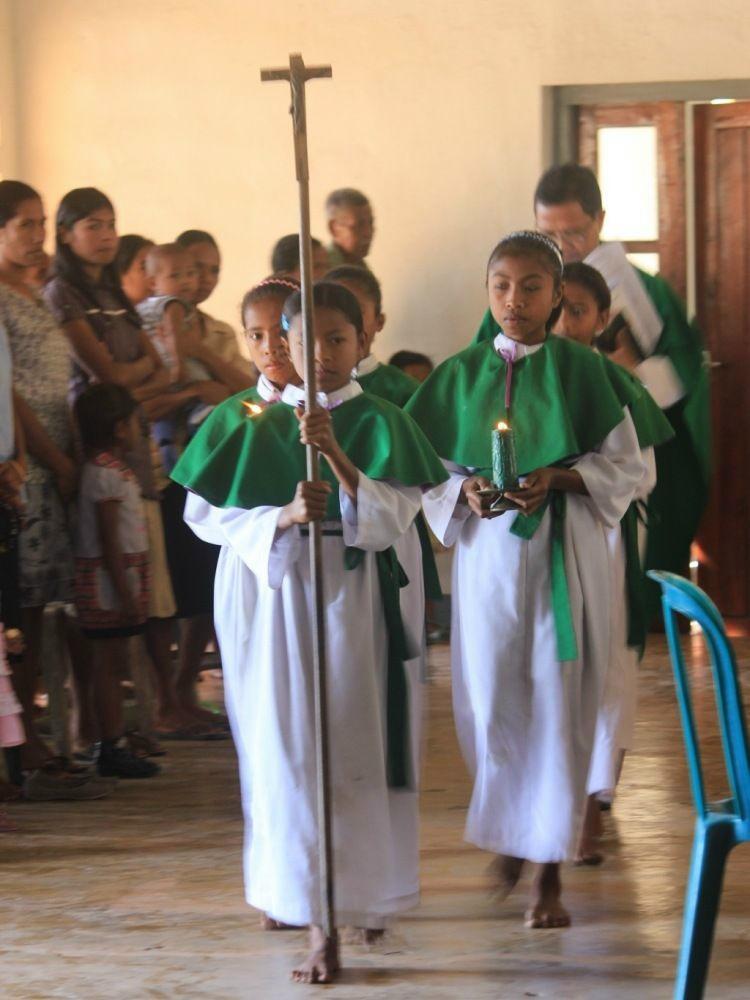
Indonesian Christianity: Denominations

Figure 1.--The photo was taken on Flores, one of the Lesser Sunda Islands, Indonesia. Most of the Islanders are Catholic. Indonesia is largely Muslim, but because of missionary activity there are several tribal groups and small islands whuich are largely Christian. The photo was taken on Sunday, at the beginning of the Mass. It seems that there are only all girls. We do not know if the church alternates genders or if it was mostly the girls who were interested. The girls are barefoot which seems to be part of their vestments. The congregation including the children are weaing some kind of footwear.
|
|
The majority of Indonesian Christians are Protestants of various denominations. Both Protestantism and Catholocism are among the recognized religions. The Portuguese and Catholocism arrived first in Indonesia (16th century). The Portuguese after rounding the Cape of Good Hope arrived looking for spices and what is now Indonesia which they called the Spice Islands. The Dutch Dutch East Indies Company arrived soon after. The effort of the Spanish to suppress Protestantism in the Netherlands also brought conflict in Potugues resulted in the Durch War for indepencence and fighting in Portuguese colonies such as Brazil and Portugal. There were religious ramifications to this conflict. The result was that Brazil remained Potuguese and Catholic and the Dutch East Indies (Indonesia) became Dutch and Protestant. Most Dutch officials and businessmen were Protestants. A substantial Lutheran presence developed in Jakarta. Lutheran Governor General Gustaaf Willem van Imhoff built a Lutheran church (1749). The Dutch founded the Protestantsche Kerk in Nederlandsch-Indie ("Indische Kerk") as a union of Arminian, Baptists, Lutheran, Mennonite, and Reformed denominations (1814). The Dutch king decreed that one church council oversee a union of the Protestant denominations in the Dutch East Indies (1835). There are, however, a very large number of Protestant denominations active. Unlike the effort in most Portuguese and Spanish colonies, there was not a string emphasis on converying the local population. And there was a general resistance to conversion on the part of most Indonesian Muslims. Catholic congregations grew less rapidly than Protestants during the Dutch colonial era. They apparently focused more on Europeans than the Protestants. Christians are not evenly distributed in Indonesia. And the same is true of Protestant dmominations and Catholics. Many Indonesian Christians tend to congregate based more on ethnicity than liturgical differences. Because of missionary activity, there is a clustering of Christians among severl tribal groups and on smaller islands. East Nusa Tenggara is the only province with a mjority Catholic population. Some 90 percent of the East Nusa Tenggara population is Catholic. There are of course Christians on the main islands as well. Catholics are clustered Central Java, especially in and around Muntilan.
HBC

Navigate the Boys' Historical Clothing Web Site:
[Introduction]
[Activities]
[Biographies]
[Chronology]
[Clothing styles]
[Countries]
[Bibliographies]
[Contributions]
[FAQs]
[Glossaries]
[Images]
[Links]
[Registration]
[Tools]
[Boys' Clothing Home]
Navigate the Boys' Historical Clothing national pages:
[Return to the Main Indonesian Christianity page]
[Return to the Main Indonesian religion page]
[Return to the Main Indonesian page]
[Return to the Main Oceania page]
[Return to the Main countries page]
[Australia]
[China]
[Japan]
[Malaysia]
[New Guinea]
[Philippines]
[England]
[The Netherlands]
[Portugal]
[Spain]
Created: 2:12 PM 3/13/2013
Last updated: 2:13 PM 3/13/2013



